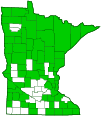gray goldenrod
(Solidago nemoralis ssp. nemoralis)
Conservation • Description • Habitat • Ecology • Use • Distribution • Taxonomy
Conservation Status |
|
|||||||
| IUCN Red List | not listed |
|||||||
| NatureServe | N5 - Secure SNR - Unranked |
|||||||
| Minnesota | not listed |
|||||||
Description |
||
Gray goldenrod (ssp. nemoralis) is one of the smallest goldenrods. It is an erect, perennial forb that rises on 1 to 10 aerial stems, but usually no more than 6, from a short-branched, woody, stem (caudex). The aerial stems are erect and covered with short grayish or whitish, ascending or appressed hairs, causing the stem to appear grayish. Basal and lower stem leaves are inversely lance-shaped (oblanceolate) or inversely egg-shaped with the attachment at the narrow end. They are ¾″ to 3¾″ long, ¼″ to ⅔″ wide and taper near the base to long, winged leaf stalks. They taper near the tip to a point with straight sides along the tip. The margins usually have rounded teeth. The upper surface is covered with fine, grayish or whitish hairs. The midvein is conspicuous, the lateral veins are feather-like. Stem leaves are alternate. Middle and upper stem leaves are attached to the stem without a stalk. They are linear-oblanceolate, ⅔″ to 1¾″ long, ⅛″ to ¼″ wide, becoming gradually smaller as they ascend the stem. The margins are untoothed. There are usually winged leaflets at the axils of the upper leaves. The inflorescence is a 4″ to 10″ long array. It is shaped like a wand, wider in the middle, and usually arching downward 90° to 180°. It has 10 to 300 flower heads appearing on one side. The flowers are about ¼″ across with 5 to 11 yellow ray florets 3 to 10 yellow disk florets. The whorl of bracts at the base of the flower head is no more than 1 ⁄6″ wide. |
||
Height |
||
6″ to 30″ |
||
Flower Color |
||
Yellow ray florets, yellow disk florets |
||
Similar Species |
||
Elm-leaved goldenrod (Solidago ulmifolia) is a taller, more robust plant. It has an erect stem with a few spreading flowering branches at the top. The stem and leaves are mostly hairless. The flower branches are much narrower than the flower cluster of gray goldenrod. The flowers have 3 to 5 minute rays. Gray goldenrod (Solidago nemoralis var. decemflora) has basal leaves that are often linear-oblanceolate. The margins usually do not have rounded teeth. The whorl of bracts at the base of the flower head is from a little more than 1 ⁄6″ to almost ¼″ wide. Showy goldenrod (Solidago speciosa var. rigidiuscula) is a taller, more robust plant. The stem and leaves are mostly hairless. The flowering spike has flowers on all sides of the central stem, usually on crowded, stiffly ascending branches. The flower has 6 to 8 ray florets and 7 to 9 disk florets. |
||
Habitat |
||
Dry. Woods, prairies, and open places. Sandy soil. |
||
Ecology |
||
Flowering |
||
August to October |
||
Pests and Diseases |
||
|
||
Use |
||
|
||
Distribution |
||||
|
Sources |
|||
| 4/27/2023 | ||||
Nativity |
||||
Native |
||||
Occurrence |
||||
|
||||
Taxonomy |
|||
| Kingdom | Plantae (green algae and land plants) | ||
| Subkingdom | Viridiplantae (green plants) | ||
| Infrakingdom | Streptophyta (land plants and green algae) | ||
| Superdivision | Embryophyta (land plants) | ||
| Division | Tracheophyta (vascular plants) | ||
| Subdivision | Spermatophytina (seed plants) | ||
| Class | Magnoliopsida (flowering plants) | ||
| Superorder | Asteranae | ||
Order |
Asterales (sunflowers, bellflowers, fanflowers, and allies) | ||
Family |
Asteraceae (sunflowers, daisies, asters, and allies) | ||
| Subfamily | Asteroideae | ||
| Supertribe | Asterodae | ||
| Tribe | Astereae (asters and allies) | ||
| Subtribe | Solidagininae | ||
| Genus | Solidago (goldenrods) | ||
| Subgenus | Nemorales | ||
| Species | Solidago nemoralis (gray goldenrod) | ||
Subordinate Taxa |
|||
|
|||
Synonyms |
|||
Solidago nemoralis ssp. haleana Solidago nemoralis var. haleana Solidago nemoralis var. nemoralis |
|||
Common Names |
|||
dyer’s-weed goldenrod dyersweed goldenrod field goldenrod gray goldenrod gray-stem goldenrod gray-stemmed goldenrod old field goldenrod old-field goldenrod |
|||
Glossary
Axil
The upper angle where the leaf stalk meets the stem.
Caudex
A short, sometimes woody, persistent stem, at or below ground level, from which aerial stems arise each year.
Linear
Long, straight, and narrow, with more or less parallel sides, like a blade of grass.
Oblanceolate
Reverse lanceolate; much longer than wide, thickest toward the tip, and gradually tapering toward the base.
Winged leaf stalk
A leaf-like or membrane-like extension along both sides of the leaf stalk.
Visitor Photos |
|||||
Share your photo of this plant. |
|||||
| This button not working for you? Simply email us at info@MinnesotaSeasons.com. Attach one or more photos and, if you like, a caption. |
|||||
|
|||||
MinnesotaSeasons.com Photos |
|||||
|
|||||

Slideshows |
||

Visitor Videos |
|||
Share your video of this plant. |
|||
| This button not working for you? Simply email us at info@MinnesotaSeasons.com. Attach a video, a YouTube link, or a cloud storage link. |
|||
Other Videos |
|||

Visitor Sightings |
|||||
Report a sighting of this plant. |
|||||
| This button not working for you? Simply email us at info@MinnesotaSeasons.com. Be sure to include a location. |
|||||
|
|||||
MinnesotaSeasons.com Sightings |
|||||

|
Created: Last Updated: © MinnesotaSeasons.com. All rights reserved. |
